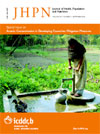
|
The Journal of Health, Population and Nutrition
icddr,b
ISSN: 1606-0997
EISSN: 1606-0997
Vol. 27, No. 5, 2009, pp. 684-695
|
 Bioline Code: hn09068
Bioline Code: hn09068
Full paper language: English
Document type: Research Article
Document available free of charge
|
|
|
The Journal of Health, Population and Nutrition, Vol. 27, No. 5, 2009, pp. 684-695
| en |
Evaluating the Experience of GAPS—A Methodology for Improving Quality of Mass Immunization Campaigns in Developing Countries
Weiss, William M.; Burnham, Gilbert & Winch, Peter J.
Abstract
The existence of pockets of under-vaccinated persons has allowed outbreaks of disease in countries that
have achieved high levels of vaccination coverage. A field-based methodology—GAPS (Geographic Assessment
of Planning and Services)—was developed to predict, in advance of an immunization campaign, the
sites of which are most likely to have a pocket of unvaccinated persons and then use this information to
improve planning, supervision, and evaluation of the campaign. At this time, there have been two applications
of GAPS (Nepal and Ethiopia). The purpose of this paper was to evaluate these two applications of
GAPS and make recommendations regarding its future use. Structured, expert interviews were conducted
with at least three campaign organizers to evaluate each application of GAPS using purposive sampling.
An evaluation of an individual campaign was considered positive when at least two of the three campaign
organizers considered GAPS to be useful and worthwhile. The three campaign organizers interviewed following
the GAPS application in Ethiopia responded that GAPS was useful and worth the effort. In Nepal,
all four campaign organizers responded that GAPS was useful and worth the effort. Some suggestions for
improvement were also identified. Although this evaluation was limited in the number of applications
evaluated, GAPS appears to have promise as a practical method to help improve the quality of mass immunization
campaigns. And even if no pockets of unvaccinated persons are found, the method may serve as
a rapid quality-check of administrative estimates of coverage. Further applications in different settings are
needed to confirm these findings or under what circumstances GAPS might best be used. GAPS may also
be considered for improving other types of health campaigns, such as distribution of insecticide-treated
bednets, vitamin A capsules, and deworming medications.
Keywords
Child health; Evaluation studies; GAPS; Immunization; Polio; Developing countries
|
| |
© Copyright 2009 - International Centre For Diarrhoeal Disease Research, Bangladesh
Alternative site location: http://www.jhpn.net
|
|
